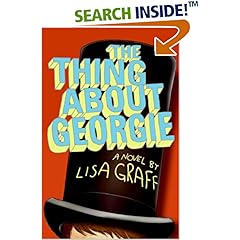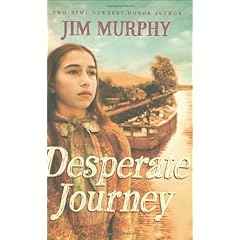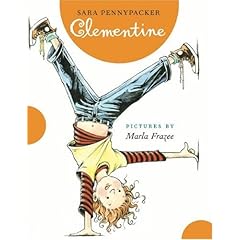The Cybil Award winners will be announced this afternoon (2/14/07) at 2 p.m., CST. Watch this space for more information, or go directly to the Cybils website.
So, they couldn’t wait and announced early. Here they are —the 2006 Cybil Award Books. Check them out.

Fantasy and Science Fiction:
Ptolemy’s Gate (The Bartimaeus Trilogy, Book 3)
Jonathan Stroud
Hyperion: Miramax
Ptolemy’s Gate receives the first Cybils for Fantasy and Science Fiction for its richly imagined fantasy world, strongly realized and unique characters, delightful language and well-honed plot. As a concluding volume of a trilogy, it delivers everything a final volume should do, taking the story arc to its peak with a climax that is both action-packed and emotionally charged. At the same time, Ptolemy’s Gate stands alone as a story and will inspire readers, children and adults alike, to seek out the previous installments and revisit the world of Bartimaeus over and over again.

Fiction Picture Books:
Scaredy Squirrel
by Melanie Watt
Kid’s Can Press
This eponymous squirrel hits little kids and big alike right where they live: in the numbing comfort of routine and abject fear of The Unknown. This is a tiny book with a big lesson about bravery. Watt makes the most of each page, using repetition and exaggeration to hilariously dissect Scaredy Squirrel’s paranoia, from the minutiae of his daily habits to a tour of his emergency kit. When the unexpected finally occurs, the joke’s on all of us. Field-tested in libraries and living rooms and at bedsides by the judges, Scaredy Squirrel elicited the most giggles per page and requests for re-reads among a variety of age groups, including parents.

Graphic Novels:
Ages 12 and Under:
Amelia Rules! Volume 3: Superheroes
by Jim Gownley
Renaissance Press
Amelia Rules celebrates the power of imagination when school lets out for summer vacation. There’s plenty of time for dressing up in capes, fighting a gang of evil ninjas, and investigating the evil conspiracy known as the Legion of Steves. Amelia McBride’s adventures are portrayed with warm-hearted good humor. There’s plenty of slapstick comedy, which combines with an exploration of some of the serious issues of childhood – moving, growing up, and the secret a new friend tries to hide. Jimmy Gownley’s art shifts styles based on his character’s vivid inner worlds, portraying superhero space battles and silent movie romances with ease. Amelia Rules can be easily be enjoyed by readers of all ages.

Ages 13 and Up:
American Born Chinese
Gene Yang
First Second
American Born Chinese skillfully explores the idea of identity by weaving together three distinct stories – the traditional tale of the Monkey King, Jin Wang’s longing for acceptance by his classmates, and popular Danny being plagued by his cousin Chin-Kee who embodies the worst Chinese ethnic stereotypes. Gene Yang uses humor when portraying the perils of adolescence, and his colorful art easily adapts to the tonal shifts of the three stories.

Middle Grade Fiction: This is the one I helped choose, and I’m rather proud of it. I feel as if I helped write the book or publish it or dotted an i or something. Anyway, read it; it’s a good book.
A Drowned Maiden’s Hair: A Melodrama
by Laura Amy Schlitz
Candlewick Press
It’s a mystery story, it’s a ghost story, it’s delightully gothic and eerie. In A Drowned Maiden’s Hair we have a protagonist with a very authentic child voice, and her motivations and feelings are described in clean, nuanced lines. Maud is also a person of her time and place; she never comes off as anachronistic. The story, too, is something of a time and place–the darkness of the Hawthorne estate was like an L.M. Montgomery novel gone delightfully to seed.The adoption of the plucky orphan by the wealthy lady is a trope of the Victorian novel, and yet does not come off as trite or formulaic. It is as if Schlitz had taken familiar characters and plotlines from Victorian fiction and injected them with a realism and emotional force that transcends its familiarity, making it seem new again. Truth–be it in the cries of a widower, or in a tearful confession–is what lets Maude see her true role and path, and ultimately brings redemption.

Non-Fiction, Middle Grade and Young Adult:
Freedom Walkers: The Story of the Montgomery Bus Boycott
by Russell Freedman
Holiday House
The story of the Montgomery Bus Boycott has been told many times by many different people and has almost become legend, but in Freedom Walkers, Russell Freedman is not sharing folklore or the iconic stories of civil rights heroes like Martin Luther King Jr. or Rosa Parks. This book tells how ordinary men, women and children planned and worked together to peaceably stand up against the injustice of the segregated transportation system–and won. Their heroism makes the reader ask, “Could I do this? Could I stand up to the threats? Could I walk to school every day for almost a year to make justice happen in my hometown?” Well-chosen historic photographs bring to life the American South of the 1950’s. The true story is gripping and well documented. This is a read-in-one- sitting kind of book, which will appeal to young teens up through adults.

Non-Fiction Picture Books:
An Egg Is Quiet
written by Dianna Aston; illustrated by Sylvia Long
Chronicle Books
Don’t be surprised if some future master birder cites this book as an early influence. Multiple layers of thoughtful, poetic text–about not only birds but also insects, reptiles and sea creatures–make An Egg Is Quiet a book that readers can enjoy quickly or in depth, depending upon their level of interest. The handwriting font gives the feeling of a scientific field journal, and the artwork is of the first class, with outstanding visual variety and clarity. The endpapers alone are breathtaking.

Poetry:
Butterfly Eyes and Other Secrets of the Meadow
written by Joyce Sidman, illustrated by Beth Krommes
Houghton Mifflin
Three cheers for Butterfly Eyes and Other Secrets of the Meadow! Each poem is a nature riddle–guessing the answers will keep children hopping. Joyce Sidman’s rich, rhythmic language and Beth Krommes’ intricate scratchboard illustrations make the Cybils poetry winner a book to return to again and again.
You can purchase any one (or all) of these books via Amazon by clicking on the cover picture. Or take a trip to the bookstore and purchase your Cybil Award books there. Either way, you have some good reading in store for you. (The blurbs were written by the judges in the various categories, not by me.)
 The thing about Georgie Bishop is: he’s a dwarf. Well, that’s one thing about Georgie. The point of the book is that there’s a lot more to Georgie than just his being a dwarf, even though that’s definitely part of who he is. Georgie is also a dog walker, an actor, a song writer, Andy’s best friend, and he’s about to become a big brother.
The thing about Georgie Bishop is: he’s a dwarf. Well, that’s one thing about Georgie. The point of the book is that there’s a lot more to Georgie than just his being a dwarf, even though that’s definitely part of who he is. Georgie is also a dog walker, an actor, a song writer, Andy’s best friend, and he’s about to become a big brother. 

















